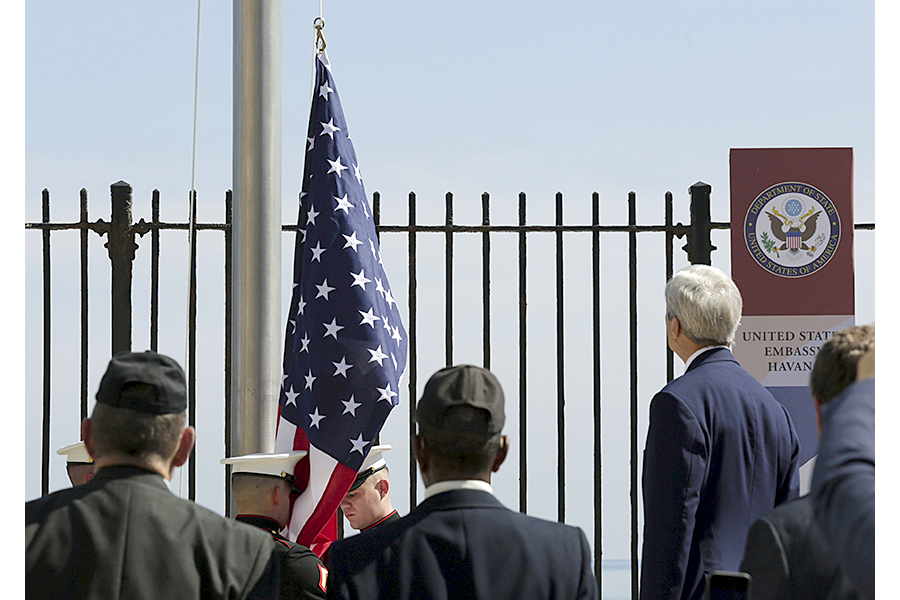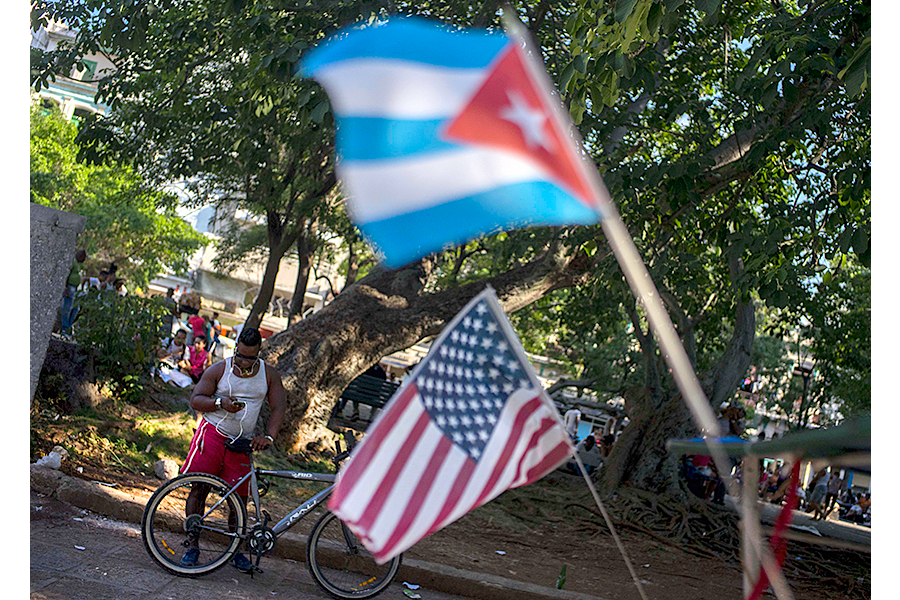US flag flies again in Cuba: How much real change is coming to the country?
Loading...
| Washington
When Secretary of State John Kerry raises the Stars and Stripes over the reopened US Embassy in Havana Friday, there will no longer be a menacing billboard blaring an anti-imperialist message from across the street.
And no longer will Cuban security authorities be taking down the name of every Cuban citizen entering the American diplomatic mission – as happened for years until the two long-estranged governments reopened their respective embassies last month.
But as symbolically significant as Friday’s ceremony along Havana’s waterfront Malecón will be – it will be the first visit to Cuba by a secretary of State since 1945 – it remains unclear how much real change the warm-up in US-Cuba relations will bring.
For both bilateral government relations and the Cuban people, experts in US-Cuba relations predict change will occur, but will be slow.
“Cuba is changing, but that change is not happening fast enough. Cuba needs to speed up the process of change,” says Carlos Saladrigas, chairman of the Cuba Study Group, an organization of Cuban-Americans supporting President Obama’s opening to Cuba.
Change, he says, will be slowed by drags on the process both from inside Cuba and from the United States. The US embargo, which can be lifted only by Congress, will continue to act as a brake on change, he says, even as the Cuban government’s fears of losing control of the country’s political and economic evolution join in slowing things down.
“Cuba cannot change as long as the embargo is in force,” says Mr. Saladrigas, who blames the trade impediment for limiting the ability of US businesses to interact with Cubans and encourage their entrepreneurial spirit.
He also blames a timid and wary Cuban government for the slow pace of change. Noting that the communist government’s much-ballyhooed list of allowed private-sector self-employment activities has not changed in four years, he says, “That’s been a disappointment.... You cannot ignite an economy by going so slow.”
Evidence that the US also intends to go slow in pressing for change in Cuba could be found in Friday’s agenda.
Secretary Kerry’s day in Havana is expected to be heavy on symbolism yet cautious in terms of its political engagement with Cubans. The US has not invited to Friday’s flag-raising ceremony any of the political dissidents it has worked with for years to foster political change in Cuba, State Department officials confirmed Wednesday.
In interviews this week, Kerry characterized the ceremony as a “government-to-government” affair that wouldn’t have the space to accommodate everyone. He said he would meet later in the day with dissidents and human rights groups.
Kerry is now expected to hold a separate flag-raising ceremony with human rights advocates and other representatives of Cuban civil society at the residence of the Embassy’s chief of mission.
State Department officials said the two-ceremony solution would avoid the prospect of Cuban government officials boycotting the Embassy ceremony – a slap that would have gotten reestablished relations off to a sour start.
But critics of Mr. Obama’s normalization of relations with Cuba quickly jumped on the relegation of dissidents to a side ceremony as further proof of what they see as the administration’s willingness to bend over backward to meet Cuban government demands.
“Cuban dissidents are the legitimate representatives of the Cuban people and it is they who deserve America’s red carpet treatment, not Castro regime officials,” Republican presidential candidate and Florida Sen. Marco Rubio said in a statement Wednesday. He called Kerry’s arrangement for a separate low-key meeting with dissidents a “slap in the face” to Cuba’s democracy advocates.
The sanitized guest list at the Embassy’s flag-raising ceremony may ensure attendance by high-level Cuban officials, but that does not mean the Cuban government has gotten over its suspicions of US intentions, say some Cuban experts close to the government’s thinking.
A sizable share of the Cuban government and political elite suspects that the heralded Obama opening to Cuba is really only a “change in tactics,” says Carlos Alzugaray Treto, a professor at the University of Havana’s Center for Hemispheric and United States Studies.
The fear is that the new US approach to Cuba is still about “regime change,” he says, only now it’s in seductive clothing. “Politically it’s like the Roberta Flack song, it’s ‘Killing me softly with [your] song,’ ” says Professor Alzugaray, who like Saladrigas spoke Thursday on a conference call arranged by the Wilson Center in Washington.
The mantra for that part of the government is, “We cannot trust these guys,” Alzugaray says. Reinforcing that sector’s skepticism is a continuation of what the former Cuban diplomat calls “subversive policies towards Cuba,” including US government TV and radio broadcasts into Cuba, the US military base on Cuban territory at Guantánamo, and especially the embargo.
“The embargo is the symbol of the regime-change policy of the US towards Cuba,” he says.
Still, Alzugaray says change is coming to Cuba, nudged forward by more than just the normalization of relations with the US. Other “big change elements” at work, he says, are a continuing transition to a new economic model and the country’s “generational transition” – from the generation of the revolution to a much younger generation.
Those forces will also usher in new pressures for political change and an “expansion of the democratic bases of Cuban society,” Alzugaray says.
But those pressures for change will continue to be restrained by the decades-old “siege mentality” in Cuba engendered by the US trade embargo. So his advice to Americans who want to see change in Cuba? Lift the embargo.
“If you lift that,” he says, “there will be more stimulus for a debate in Cuba.”










